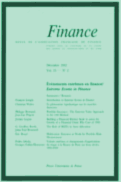

Extreme events in finance, such as stock market crashes, have always been a fascinating subject. If many books by historians have been devoted to qualitative descriptions of these events, little attention has been paid to quantitative explanations. Recently, statistical methods - especially extreme value theory - have been proposed to deal with these events in a quantitative way. This special issue of Finance is aimed at collecting original contributions in this new area of research. The choice of this subject for this special issue of Finance has been motivated by two ideas: first, the on-going debate on the modeling of the distribution of asset returns, and second, the timely issue of its application to the measurement of risks in financial institutions due to recent advances in financial regulation. In both subjects extreme values matter and are at center stage.
The paradigm for describing the behavior of asset returns has long been the normal distribution. It is described by two parameters only: its mean and its variance (or standard deviation) and the main advantage is its stability under aggregation: if the returns of two assets are normally distributed, then any combination of these two assets is also normally distributed. Such a tractable result is particularly interesting in portfolio management and risk management. However, many empirical studies have shown that the distribution of asset returns observed in real financial markets is not well fitted by the normal distribution. While the tails of the normal distribution are thin and therefore give a low probability to extreme events, the tails of the historical distribution are fat as the probability of extreme events is relatively high. Alternative models to the normal distribution have been proposed and a natural question arises: how to choose among the different models?
Financial institutions and regulators are concerned with extreme events. Market, credit and operational risks may lead to great financial losses for a particular institution and to financial instability for the financial system as a whole. In order to measure and control these risks, a regulation framework has been progressively implemented. The first step dealt with credit risk, in 1988, when the balance sheets of a bank had to respect a minimum capital ratio (known as the Cooke ratio). A few years later a regulation on market risks (equities, foreign exchange, interest rates and commodities) known as the 1996 Basel Agreement was introduced. Banks could then choose between the standard method (a set of specified rules) and the internal model method (an in-house model). This is also the case for credit and operational risks in Basel II. A trend in the regulation of financial institutions is the quantitative treatment of these risks. Financial institutions choosing to build internal models can develop sophisticated methods to measure risks. Two questions usually arise: how to model extremes observed in the tails and how to aggregate the different risks?
The selected papers of this special issue of Finance are:
 The asymptotic distribution of extreme stock market returns
The asymptotic distribution of extreme stock market returns
 From VaR to stress testing : the extreme value approach
From VaR to stress testing : the extreme value approach
 Extreme correlation in international equity markets
Extreme correlation in international equity markets
 Retour à la liste des publications
Retour à la liste des publications
 Conseil en gestion des risques
Conseil en gestion des risques
 Glossaire de termes financiers
Glossaire de termes financiers